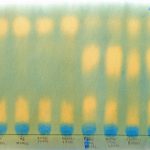How to do paper chromatography
Paper chroma-whata??
Paper chromatography: the way that home winemakers (and some commercial winemakers) check to see if their wines have completed malolactic fermentation or if they are still in the process of it. This is the time of year that winemakers are staying up on at what point their wine is at in the process of malolactic fermentation, because it will dictate when they can add potassium metabisulfite for the first time to their finished wine.
Why is it important?
Some wines should go through MLF for stylistic and stability reasons, whereas others should not.
How do I do it?
You’ll need to get a paper chromatography kit. This includes 3 acid standards (malic, lactic, tartaric), the solvent solution, chromatography paper, capillary tubes, and a plastic jar.
How accurate is it?
That’s the thing – it’s more qualitative than quantitative. Maybe it will show that there is still malic acid present, but that doesn’t mean it tells you how much is present, how long it’s been at this point, or if it’s even still decreasing anymore. It is qualitative in the sense that it shows: yes, acid X is present, or no, acid X is not present. If you’re searching for a more exact number or reference point you can send your samples in to a lab – if you’re looking to get an overall picture of whether or not your wine has any malic acid or lactic acid present, then using paper chromatography is the way to go.
What does this stuff look like?
How do I do it?
- Collect your wine samples
- Draw a line 1-2 inches from the bottom of the paper using a pencil (pen will not work)
- Mark with an X or dot where you will place the samples.
- Use capillary tubes (one for each sample – don’t mix them up) to draw up a very small sample of the the standards (malic, lactic, and tartaric) and then the wine samples and drop a very small amount of the liquid onto the paper. You will notice it will spread out once it hits the paper so be sure not to drop too much liquid. Less is more here.
- Let the dots dry and repeat 3 times. This will make it easier to read down the road.
- Roll the paper up and staple either side without the paper overlapping onto itself.
- Pour a small amount of paper chromatography solvent solution into the bottom of the plastic jar. Be careful to not inhale this. Place the stapled paper, sample side touching the solution, into the jar. Screw the lid on and let sit for ~8 hours, or enough time for the solvent to reach from the bottom to the top of the paper.
- Take the paper out (carefully) and let it air dry until the entire sheet turns blue and yellow dots are clearly visible.
- Match up where you see specific acid dots with the wine samples and you can detect if malic and/or lactic acid is present in each sample.
Helpful hints
You will likely need to run this test at least a couple of times to see the decline in MLB and confirm its completion
Be sure not to add any potassium metabisulfite to your wine until MLF has completely finished!
Use space heaters or a warm room for wines undergoing MLF to help speed the process along
Collect your test samples







Recent Comments